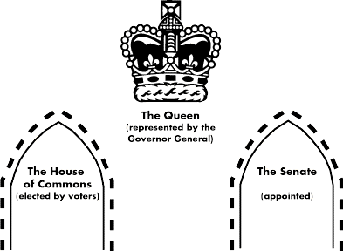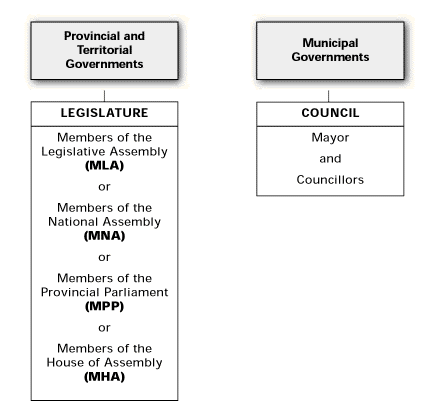Government
Federal Elections
Canadians vote in elections for the people they want to represent them in Parliament. With each election, the people may reelect the same members of Parliament or choose new ones.
Federal elections are usually held every four years. The Prime Minister may ask the Governor General to call an earlier election. According to Canada's Constitution, an election must be held within five years of the last election.
Canada is divided into 301 electoral districts. An electoral district is a geographical area represented by a member of the House of Commons. The citizens of each electoral district elect one member of Parliament who sits in the House of Commons.
Any Canadian citizen who is at least 18 years old can run in a federal election. The people who run for office are called candidates. There can be many candidates in an electoral district.
The people in each electoral district vote for the candidate of their choice. The candidate who receives the most votes becomes the MP for that electoral district.
An elected MP represents everyone who lives in his or her electoral district, even the people who did not vote for the MP. Your MP is your link to the federal government. Your MP helps you by:
representing your ideas when new laws are being proposed;
asking questions about the government on your behalf; and
helping you if you need information from the government or if you have any problems with the government.
It is easy to contact your MP. To find his or her name, look in the blue pages of the telephone book under "Government of Canada." Call the toll-free number under "Information on the Government of Canada." Give your address to the information officer who answers your call and he or she will give you the name and telephone number of your MP.
Your MP has an office in your electoral district. You can also write to your MP by sending your letter to:
House of Commons
Ottawa, Ontario
K1A 0A6
You should be aware that letters sent to MPs in Ottawa do not need stamps.
Political parties
Most candidates in federal elections belong to a political party. A political party is a group of people who share ideas about how the government should work. Some political parties have been around for a long time but Canadians can create new political parties at any time.
Members of political parties hold meetings where they discuss their ideas and opinions. They develop plans for what they would do if their candidates were elected to form the government. The plans they make are called the party platform.
Members of political parties help to:
decide on the party platform;
choose the party leader;
choose the party's candidates; and
campaign for party candidates in elections.
Candidates who do not belong to a political party are called independents.
Voting
One of the privileges and responsibilities of Canadian citizenship is the right to vote. Elections Canada is the non-partisan agency of Parliament responsible for conducting federal elections and referendums.
You can vote in a federal election or cast a ballot in a federal referendum if you are:
a Canadian citizen and
at least 18 years old.
The voters lists used during federal elections and referendums are produced from the National Register of Electors, a permanent database of Canadian citizens 18 years of age and older, qualified to vote in federal elections.
The National Register of Electors contains the name, address, sex and date of birth of each qualified elector. Elections Canada updates the National Register of Electors through existing data sources, including additions from Citizenship and Immigration Canada.
It is important that your name be added to the National Register of Electors as soon as your citizenship is granted and you become eligible to vote.
When you apply for citizenship, you have the opportunity to check a box on the application to indicate your consent to the transfer of your name, address, sex and date of birth to Elections Canada. Only the data given by new Canadians who have indicated this consent are transmitted to Elections Canada. The information can be used only for electoral purposes. Even if you choose not to be listed, you still have the right to vote. Your name can be added to the voters list right up to election day.
Once an election has been called, Elections Canada mails a Notice of Confirmation of Registration card to each elector whose name is in the National Register of Electors. The notice tells you when and where to vote. If you require an interpreter or other special services, it tells you the number to call.
Even if you do not receive a Notice of Confirmation of Registration card, you can still be added to the list right up to election day. For information on how to do this, contact Elections Canada. During an election period, your local newspaper will print the telephone number for the Elections Canada office in your electoral district. If you cannot find the number, call Elections Canada toll-free at 1-800-463-6868 or 1-800-Info-vote.
To vote either on election day or at advance polls, go to the polling station listed on your Notice of Confirmation of Registration card. An election official will give you a ballot. The ballot lists the names of the candidates in your electoral district in alphabetical order.
Mark the ballot by writing an "X" in the circle beside the name of your chosen candidate. Next, fold the ballot so that no one can see your vote. Then, either put the ballot in the ballot box or ask the election official to do it for you.
Canada's election laws say that your vote is secret. This means that no one can watch you vote and no one should look at your marked ballot. You may choose to discuss how you voted with others, but no one has the right to insist that you tell them how you voted.
Immediately after the polling stations close, election officials count the ballots, and the results are announced on radio and television, and in the newspapers.
After an election
After an election, the party with the most elected representatives becomes the party in power. The leader of this party becomes the Prime Minister. The Prime Minister and the party in power run the government as long as they have the support of the majority of the Members of Parliament (MPs), in the House of Commons.
The Prime Minister chooses several MPs to become Cabinet ministers. Cabinet ministers are responsible for running the federal government departments. The Prime Minister and the Cabinet ministers are called the Cabinet, and they make important decisions about how to run the country. They also propose most new laws. Their decisions can be questioned by all MPs in the House of Commons.
If a majority of the MPs vote against a major government decision, the party in power is defeated. The Prime Minister resigns and a new election is usually held.
The parties that are not in power are called the Opposition parties. The Opposition party with the most MPs is the Official Opposition. The role of the Opposition parties is to oppose or try to improve government proposals.
Voting Procedure
|
1
|
Data from the National Register of Electors is used to produce the list of electors.
|
 |
2
|
The Confirmation of Registration card confirms that your name is on the list of electors.
|
 |
3
|
If you do not receive a Confirmation of Registration card, call the Elections Canada office for your electoral district.
|
 |
4
|
If you need to, you can vote in advance at the advance polls or by special ballot.
|
 |
5
|
On election day, go to your polling station. You will be given a ballot paper.
|
 |
6
|
You vote by secret ballot.
|
 |
7
|
Mark an "X" in the circle to the right of the name of the candidate you prefer.
|
 |
8
|
You or an election official will put your secret ballot in the ballot box.
|
 |
9
|
The ballots are counted and the results are announced to the public.
|
 |

